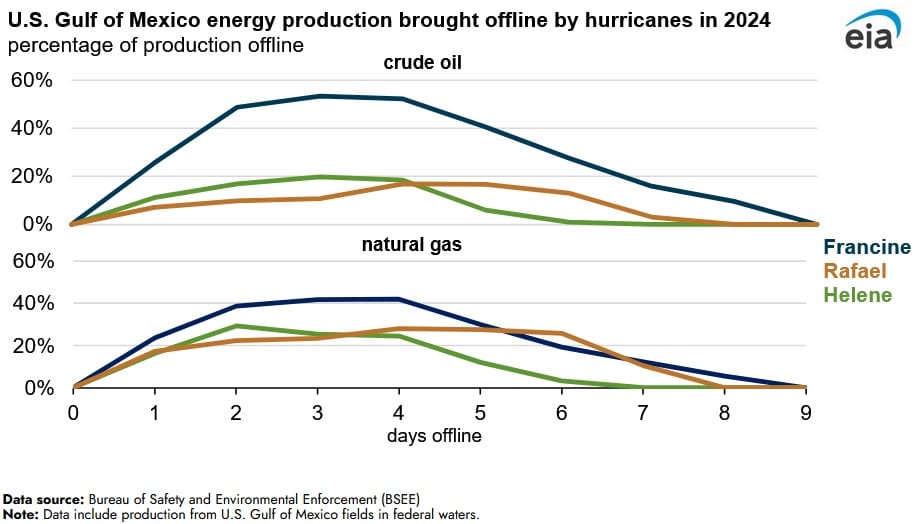2024 Atlantic Hurricane Season Exhibits Above Average Activity: EIA

The 2024 hurricane season displayed above average activity, with more hurricanes and named storms than usual, according to an Dec. 17 report published by the U.S. Energy Information Administration. Several hurricanes and storms negatively impacted U.S. energy infrastructure, particularly in the Southeast and Gulf Coast. Electricity markets were in particular impacted by hurricanes during the season, however they also impacted oil and natural gas production.
The National Oceanic Atmospheric Association (NOAA) reported 18 named storms during 2024, with 11 of these storms having wind speeds above 74 mph, categorizing them as hurricanes, whilst five had wind speeds of 111 mph or above, classifying them as major hurricanes. Five hurricanes made landfall in the U.S. (Helene, Beryl, Francine, Debby and Milton), with two storms (Milton and Helene) making landfall as major hurricanes. According to the NOAA, on average the hurricane season has 14 named storms, seven hurricanes and three major hurricanes. During the 2023 Atlantic hurricane season there were 20 named storms, with only one hurricane making land in the U.S. Storms during the 2023 Atlantic hurricane season had an insignificant impact on production in the U.S. oil and gas sectors.
Hurricanes mainly impact the petroleum sector by interrupting crude oil production and refinery operations. Offshore crude oil in the U.S. is focused in the Federal Offshore Gulf of Mexico (GOM) and is negatively impacted by extreme weather. Offshore oil and gas assets must cope with threats linked with hurricanes and tropical storms, and must adhere to emergency protocols to vacate employees and provisionally cease production.
Hurricanes Milton and Helene that arrived on Florida’s Gulf Coast caused significant electricity outages and disruption to electricity infrastructure on their pathways through Florida to states such as South Carolina, Georgia, Tennessee, North Carolina and Virginia. Hurricanes Debby and Beryl had an insignificant impact on the U.S. Gulf Coast natural gas and oil industry.
The agency estimates that unplanned outages of crude oil production in the U.S. GOM resulting from storms averaged 295,000 barrels per day (b/d) during September and 110,000 b/d during November, accounting for 16 percent and five percent, respectively, of total crude oil production from federal GOM waters during those periods. Unplanned outages of natural gas production in the GOM resulting from storms averaged 0.20 billion cubic feet per day (Bcf/d) during September and 0.07 Bcf/d in November, accounting for 11 percent and 3 percent, respectively, of total natural gas production from federal GOM waters during those months.
EnerKnol Pulses like this one are powered by the EnerKnol Platform—the first comprehensive database for real-time energy policy tracking. Sign up for a free trial below for access to key regulatory data and deep industry insights across the energy spectrum.
ACCESS FREE TRIAL